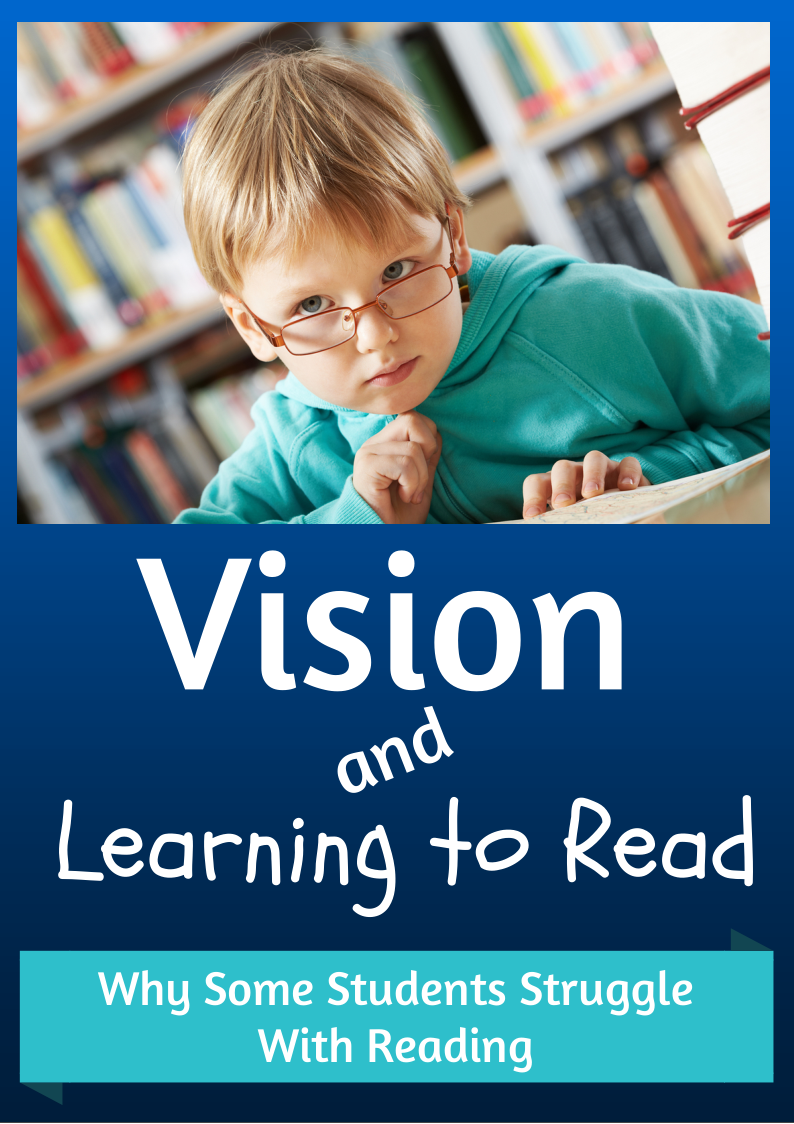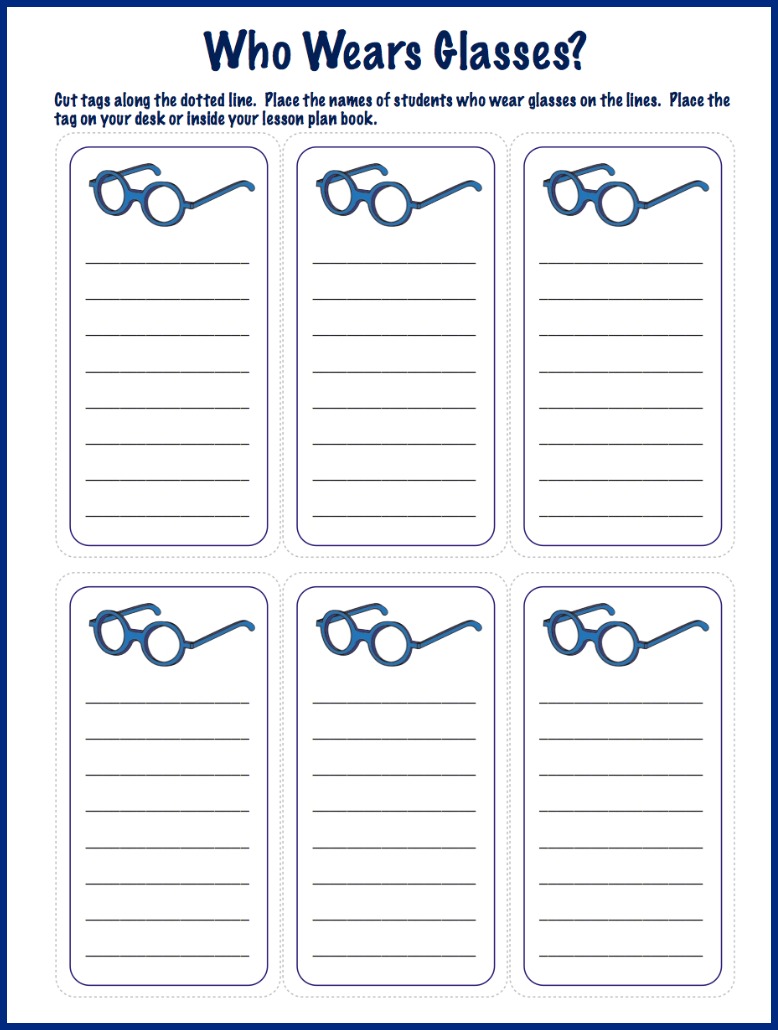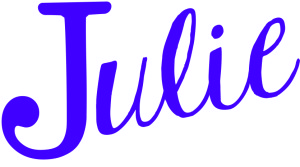It happened again. I’m reviewing a file of a student having difficulty learning to read and there it is! A recording of three failed school vision screenings. I would love to say that this is an isolated incident, but unfortunately, all too often we seem to overlook the obvious. With all of our literacy screenings, progress monitoring, digging deeper assessments, we have all seemed to neglect the possibilty that the child may not even be able to see the text clearly. We assume that the parents, after receiving the letter from the health department, followed through on the recommendation for further vision testing. Ugg…. what valuable instructional time has been lost.
Another frustration is that many children who actually are prescribed glasses are not wearing them during school. I can’t tell you how many times I go to work with a child, ask the child to bring their glasses and wait patiently as the child digs through their backpack in search of the glasses case. Yikes! Does this mean that the child did not wear their glasses during guided reading? With 80% of childhood learning processed through vision, and knowing that 25% of children K-6 have vision related issues, it’s critical that we know which children have issues with their vision.
Vision plays a critical role in learning to read. Not only do children need to be able to see the print clearly, they must also be able to coordinate the movement of their eyes. They must also be able able to “track”–meaning that they are able to follow a line of print without losing their place and their eyes need to be able to focus on the print and make quick adjustments as they move from the page to the board and back. Children must also be able to interpret and accurately process what they are seeing. Sounds a bit complicated? Maybe, but a difficulty in any one of these areas can have a pretty dramatic impact on the child’s ability to read.
Eye Teaming Problems
Children with eye teaming problems may see the print as blurred, scrambled or as doubled. Our eyes work as a team. When the eyes look at an image, let’s say a word on a page, each eye sends a separate message to the brain. The brain then combines each image into a single picture. If the eyes are not aiming at the exact same point, each image that’s being recorded is slightly different. If the images sent to the brain are greatly different, the brain cannot combine the images into a single picture. The child’s vision will then be blurred.
Tracking
Children with tracking problems often lose their place in text, skip line, misread short words. They have great difficulty controlling the fine motor eye movements at a close range.
Focusing
When reading, the eyes must maintain a clear sharp images for extended periods of time. The eyes must also be able to shift easily and focus from near and far. For example, the student must be able to look at the print on a page, look up at the teacher, and then look back on the page. This is a quick transition and the eyes must be able to quickly adjust to the changing distance. Children with focusing issues may experience an increased blurriness in print the longer they read. Their eyes may easily fatigue.
Visual Perception
Visual perception is the ability to understand and use the information that is seen. Students with visual perceptual difficulties may have difficulties in the following areas:
- Visual discrimination- notice and compare the features of different items and to distinuish one item from another. Children with visual discrimination issues may have difficulty distingishing between similarly spelled words (e.g. was/saw).
- Visual figure-ground discrimination- ability to distinguish between a shape or printed character from its background. Children with figure-ground issues may be confused with too much print on a page.
- Visual sequencing- the ability to see and distinguish the order or symbols, words or images. Children with visual sequencing issues may omit or transpose letters.
- Visual motor processing- using visual feedback to coordinate body movements.
- Visual memory- ability to engage in short-term and long-term recall of visual information. Children with visual memory issues have difficulty remembering what a word looks like. They may fail to recognize the same word on the next page.
- Visual closure- ability to know what an object is when only parts of it are visible. In terms of reading, children with visual closure issues may confuse similar words or objects. They may not quickly recognize words by sight as they need to individually process each letter in every word.
- Spatial relationships- ability to understand how objects are positioned in space.
Well, having glasses is just the start. There are definitely visual issues, other than acuity alone, that could be the cause or a contributing factor with difficulties in learning to read. Unfortunately, the screenings offered within the school do not detect all visual issues relating to the ability to access print. Children who are experiencing reading difficulties really need to receive a complete eye exam.
As educators, it’s our responsibility to ensure that our students are able to access the educational experiences that we offer. For students with visual difficulties, that education is clearly compromised when they cannot see or process text. For all students, but especially for those who are struggling, please look through the student file to see if there is a record of failed vision screenings. Also, make it a point at conference time to recommend an eye exam. For those students who are already prescribed glasses, please be sure to set up systems in your classroom to ensure that the students wear them. Here are some ideas for reluctant glasses-wearers:
- Have a discussion with the student clearly outlining your expectations that the glasses will be worn in the classroom.
- Set up a predictable routine with the student. For example, in the morning, right after attendance, the glasses are to be put on.
- Have the student keep the glasses in a specific area of his/her desk.
- Have a non-verbal cue with the student for when you notice he/she is not wearing the glasses.
- For students who routinely forget their glasses at home, if possible, see if the parents can purchase a pair to stay at school.
- Keep a list of students who are to wear glasses easily accessible on your desk to remind you of who needs them. You may also want to attach this list to your planning book or place in other areas in the classroom where you are directly providing instruction (e.g. guided reading area). Feel free to download this file. You may wish to print the page on a full size Avery label and cut out each tag along the dotted line.
Click the following link to download this file Who Wears Glasses?
There are so many challenges that face our students today. So many of those challenges are totally out of our control. Ensuring that our struggling readers can first access the text seems like a good place to start. Encouraging parents to get an eye exam for their child and making sure that the students who need glasses to read actually use them are two things that we can do right away.





I was in the middle of a high stakes reading test with one of my English language acquisition students when she remarked, “My contacts are really making my eyes hurt. I should have worn my glasses today!”
I had no idea she wore glasses. Sadly, she wasn’t able to finish the test, even given extended timing. Your post reminds me that I’ll need to make sure she brings her glasses as a back-up during state testing this month.
Our district will start PARCC this spring, so we also need to start thinking about how well our students can read from a computer screen.
Thanks for this helpful information!
My son experienced several vision difficulties: convergence insufficiency, double vision, depth perception and nearsightedness. These vision issues can be mistaken for ADD. It makes sense. If a student can’t change between near and far vision, they naturally resort to playing with their eraser, taking apart their pen, etc. Although my son is very bright and well behaved, concentration was a huge challenge. We were lucky. I happened to attend an in-service by an eye doctor who works with these students. He was able to train my son’s eyes through vision therapy. Happily my son has now completed college.
Thanks so much for sharing. That’s a great story with a happy ending. Julie